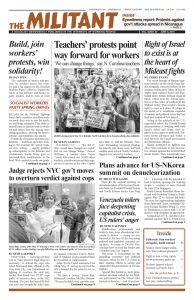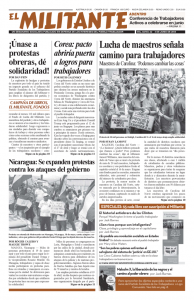Plans for the summit meeting on denuclearization of the Korean Peninsula between President Donald Trump and North Korean leader Kim Jong Un — a meeting with the potential to lead to historic openings for working people — continue to move forward for June 12 in Singapore.
South Korean President Moon Jae-in met with President Trump in Washington May 22 to discuss the talks. The next day high-ranking diplomats from Japan and China, including Chinese Foreign Minister Wang Yi, were in Washington to meet with U.S. officials to help facilitate an agreement.
A planeload of U.S. and other international reporters flew to North Korea May 22 to observe the promised dismantling of the North’s Punggye-ri nuclear testing site, scheduled to begin the next day.
The back-and-forth of positive and negative statements about the meeting by figures in the governments involved has led some in the U.S. liberal press — whose line is filtered through their hatred for the Donald Trump presidency and for the workers who voted for him — to speculate the meeting won’t happen. They have alternated between saying Trump’s belligerency will lead to war and claiming his alleged erratic incompetence will lead to the U.S. rulers being flummoxed at the talks.
White House officials said work on the summit was continuing, and a crew has been sent to Singapore to set up for the meeting.
“We’re moving along. We’ll see what happens,” Trump told the press before his meeting with Moon at the White House. “There are certain conditions we want to happen. I think we’ll get those conditions.” If not, the meeting might be postponed, he said. This is all a normal part of negotiations, the president said.
‘Trust-building’ measures
Both Washington and leaders of the Democratic People’s Republic of Korea have continued what they call “trust-building” measures. And they continue to trade complaints and demands seeking concessions heading into the talks.
After the DPRK complained about the provocative nature of Max Thunder, an annual joint U.S.-South Korean air exercises with U.S. F-22 fighter planes, Washington cancelled upcoming Blue Lightening military exercises, saying it did so at Seoul’s request.
DPRK officials also complained when White House National Security Adviser John Bolton said Libya was a “template” for the denuclearization of North Korea. Trump disavowed Bolton’s statement, saying Libya’s voluntary disarmament in 2003 did not have protections for President Muammar Qaddafi, who was deposed and killed in an uprising eight years later.
Trump said that the U.S. rulers would guarantee Kim’s position. “He will be safe. He will be happy. His country will be rich,” Trump said.
At the White House press conference with Moon, Trump said that the Chinese, South Korean and U.S. governments would channel billions of dollars to North Korea for economic development.
The Chinese government is a key player. Some 90 percent of North Korea’s trade is with China. After Beijing over the last year began strictly enforcing U.N. economic sanctions pushed by Washington, thousands of workers were laid off in North Korea, deepening pressure on the regime.
President Trump has pressed Beijing to keep exerting pressure on the North to come through on the summit. He told the press May 22 he was concerned that Chinese President Xi had started encouraging North Korea’s leaders to push against Washington in preparation for negotiations — and to help Chinese capitalists in their sharpening trade talks with the U.S. rulers.
“I can’t say that I’m happy about it,” Trump said.
It’s clear that North Korea’s massive conventional missile arsenal, thousands of missiles bunkered near the South Korean border and aimed at Seoul 30 miles away, will be part of negotiations as well. And Trump has ordered the Pentagon to prepare to draw down the number of U.S. troops deployed in the South.
Forced division of Korea
North and South Korea have been divided since 1945 when Washington and Moscow split control of the country following the defeat of Japan’s capitalist rulers in the second imperialist world war. They did so against the will of the Korean people, who had spent decades fighting to throw off Japanese occupation.
The U.S. rulers placed the South under military rule and then imposed a puppet government, crushing a revolutionary uprising by workers and farmers. When the 1950-53 Korean War erupted, U.S.-led forces drove deep into the North, almost all the way to the Chinese border. North Korean combatants fought back, and, with the help of hundreds of thousands of Chinese volunteers, were able to push Washington back to a stalemate at the 38th parallel, the first defeat ever for U.S. imperialism.
The U.S. government agreed to a cease-fire, but has refused to sign a peace treaty with the North. Some 4 million people died in the war.
If Washington and Pyongyang reach an agreement that scales back the arsenal on the border and takes steps toward removal of nuclear weapons from the peninsula, it would open the door to gains for working people. Coupled with ending the draconian economic sanctions on the North, and increasing trade and travel between North Korea and the rest of the world, it would give a renewed impulse to the fight for reunification of the country.

